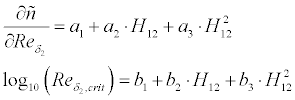The Boundary Layer Method
|
In order to calculate the friction drag of an airfoil for a given flow
condition (angle of attack, Reynolds number), an analysis of the viscous
boundary layer is necessary. From the momentum loss in this small layer on the
surface of the airfoil the drag can be derived. As the velocity distribution
changes with angle of attack, the drag changes too. Also, the thickness of the
boundary layer changes with Reynolds number.
The boundary layer module uses the velocity distribution derived by
the panel method and
performs its calculations based on the formulas presented in [14,
15, 16].
The method is a so called integral boundary layer method, which does
not handle laminar separation bubbles or large scale
separation (stall). The boundary layer module works best in the Reynolds number
regime between 500'000 and 20'000'000.
The results of the boundary layer module are also used to correct lift, drag and
moment coefficients empirically, if separation occurs. Additionally, a blending
to separated, flat plate coefficients is performed for very high angles of
attack.
The procedure starts at the stagnation point and marches along each surface,
integrating simplified boundary layer equations. The integration follows a 2nd
order Runge-Kutta scheme with stabilization by automatic step reduction. This
can be a bit slow some times, but works more reliable than the simple Newton
method used before. During the way towards the trailing edge, the method checks,
whether transition from laminar to turbulent or separation occurs.
The following empirical transition criteria have been implemented and can be
selected by the user:
If laminar separation is detected, the method switches to turbulent
flow and continues. When turbulent separation is found, the boundary
layer integration is stopped and an empirical drag penalty depending on the
length of the separated region is added to the result.
| Flow State |
Separation assumed when |
| laminar |
 |
| turbulent |
 |
The drag is applied by examining the boundary layer parameters at the
trailing edge, using the so called Squire-Young formula.
Tabular Output
The tables produced on the Boundary-Layer card contain the following columns:
| symbol |
description |
| x/l |
normalized x-coordinate |
| y/l |
normalized y-coordinate |
| v/V |
normalized surface velocity |
| d1 |
displacement thickness |
| d2 |
momentum loss thickness |
| d3 |
energy loss thickness |
| Cf |
local friction coefficient |
| H12 |
shape factor d1/d2 |
| H32 |
shape factor d3/d2 |
| flow state |
laminar, turbulent, separated |
| y1 |
the first cell height required for y+=1 (multiplied
by 100)
This value can be useful for grid generation for Navier-Stokes solvers |
For abbreviations see the quick reference page.
Last modification of this page:
21.05.18

[Back to Home
Page] Suggestions? Corrections? Remarks? e-mail:
Martin Hepperle.
Due to the increasing amount of SPAM mail, I have
to change this e-Mail address regularly. You will always find the latest version
in the footer of all my pages.
It might take some time until you receive an answer
and in some cases you may even receive no answer at all. I apologize for this, but
my spare time is limited. If you have not lost patience, you might want to send
me a copy of your e-mail after a month or so.
This is a privately owned, non-profit page of purely educational purpose.
Any statements may be incorrect and unsuitable for practical usage. I cannot take
any responsibility for actions you perform based on data, assumptions, calculations
etc. taken from this web page.
© 1996-2018 Martin Hepperle
You may use the data given in this document for your personal use. If you use this
document for a publication, you have to cite the source. A publication of a recompilation
of the given material is not allowed, if the resulting product is sold for more
than the production costs.
This document may accidentally refer to trade names and trademarks, which are owned by national or international companies, but which are unknown by me. Their rights are fully recognized and these companies are kindly asked to inform me if they do not wish their names to be used at all or to be used in a different way.
This document
is part of a frame set and can be found by navigating from the entry point at the
Web site http://www.MH-AeroTools.de/.
Impressum
Datenschutz







